In this post I demonstrate how easy it is to learn jazz guitar improvisation.
The main reason a lot of people struggle with improvisation on guitar is not that they lack the ability to do it, but that they haven’t really nutted out their method for learning it and process for practicing it. There is nothing mystical about the ability to improvise – it is a musical skill that anyone serious about music can learn, and should learn, due to the new possibilities that it can open up for you on your instrument.
Improvisation is fantastic to learn as:
- It develops your ears to match the sound of the guitar
- Opens up creative possibilities on the instrument
- Gives you the ability to jam with other musicians
- It’s great fun to do!
Rather than get too technical into the nuts and bolts of the theoretical concepts about what to do harmonically over the chord changes and so on, this lesson takes a simple minor pentatonic pattern and improvise with using some standard jazz chord changes.
How To Learn Jazz Guitar Improvisation
Learning to improvise has similarities with learning a spoken language. It is a process of learning vocabulary – however in a musical context the ‘words’ are actually musical phrases, patterns and ideas.
That’s right, you need to actually learn the phrase, patterns and ideas. Improvisation is usually not an act of complete spontaneity, of ‘making stuff up on the spot’. Imagine doing that in a spoken language context – people would think you were having some kind of esoteric spiritual experience at best, or at least will not be able to understand you at all. This is why to me I think of improvisation more like ‘speaking’ then creating. Obviously there is creativity at play however it is primarily a musical way of communicating with your listener and interacting with other musicians.
My 2 year old son is in the process of learning words. Every day he surprises my wife and I with a new one. However when he becomes an adult he’ll be able to spontaneously put the words together for the purpose of conversing. The process of learning an improvised music form is very similar to this.
Learning to Improvise can be boiled down to a few simple steps:
- Study the vocabulary. Study the melodic and harmonic patterns and ideas from guitarists or other musicians that you like, and/or ask a teacher for some ideas. For a beginner, the latter is a much faster approach (if the teacher is a good one)
- Implement the vocabulary, and just stick to one idea or lick at a time in your practice session.
- Then, start to combine the patterns/ideas/licks you have learned. At this point, your solos will naturally begin to sound much more original.
Ok – so now you know the process, let’s now learn a bit of jazz guitar improvisation. In this lesson we’ll start out on our improvisation journey with one of the most well known scale patterns used nearly universally by rock and blues players, the famous minor pentatonic pattern. As the backing track is in the key of A Minor, let’s learn this scale on fret 5 to get A minor Pentatonic:
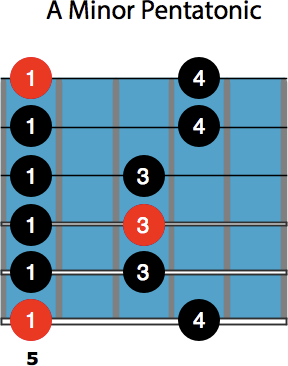
7 Simple Steps To Sounding Jazzy in Your Improvisation
The lesson video features the following 7 steps to creatively using the minor pentatonic pattern in a jazz guitar improvisation context. Fast forward the video to the time code to get to the spot in the lesson that demonstrates each step below.
Step 1: Play the minor pentatonic scale pattern over the backing track (2:58)

Step 1 involves memorising the above minor pentatonic pattern, and then just messing around a bit with as you play the scale up and down a little bit over the backing track. You don’t need to play the full scale, just take a few notes here and there and improvise with them using different rhythms and patterns.
Backing track:
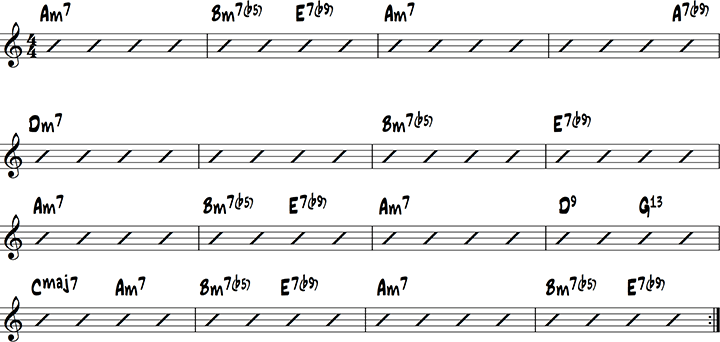
This will sound ok but won’t really sound quite sound ‘hip’ enough for jazz. To get the jazzy sound we are looking for we are going to use some key ideas from jazz vocabulary. Onwards to step 2:
Step 2: Improvise on the scale in ascending fourths (the ‘Left-Up-Right-Up’ Pattern) (3:50)

A lot of horn players include fourths intervals in their melodic solos, and this is a very convenient interval to play on guitar as the tuning of most of the guitar strings is in fourths. This means to get that jazzy horn sound on guitar you simply need to move one string across as you stay on the same fret.
The above pattern might look a bit hard to remember, but there is an easy way to navigate this one. Think of the notes played by the 1st finger as the ‘left’ side of your hand, and notes played by fingers 3 & 4 as the ‘right’ side of the hand:
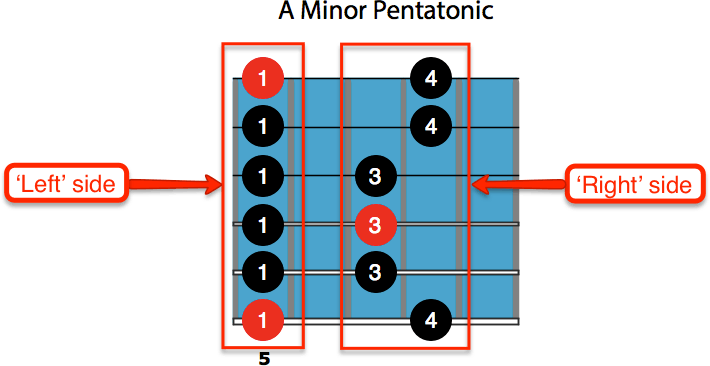
An easy way to play this pattern is to think ‘Left-Up-Right-Up’: as you play the scale cross ‘up’ to a higher string on the left side of the hand, and then ‘up’ for the right side of the hand. Play the backing track again and use only this idea as you improvise until you feel it really under your fingers.
Step 3: Improvise on the scale in ‘descending’ fourths (‘Left-Down-Right-Down’) (6:17)

This pattern is an interesting twist on the previous fourths idea in step 2. This time, follow each of the scale notes with a note a fourth below as you ascend the scale. In this case you play ‘down’ a string on the left side of your hand, and then ‘down’ a string with the right side.
Once again, play along with the backing track but just use this ‘Left-Down-Right-Down’ pattern before you move to the next step.
Step 4: Ascending followed by descending fourths (‘Left-Up-Right-Down’) (7:43)

Yet another variation on fourths patterns on the scale. Now think as if going ‘up’ 2 notes on the left side of the hand, and then ‘down’ 2 strings on the right side of the hand, hence the name of this ‘Left-Up-Right-Down’ pattern.
Once you have mastered this idea over the backing track, combine all the ideas covered from Step 1 to 4. You should find that your solo is sounding a bit ‘richer’ at this point with more variety.
Step 5: Improvise with half-step approach notes (9:00)
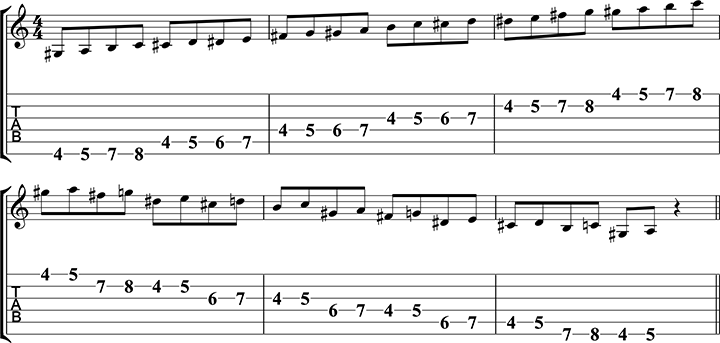
Half-step approach notes are notes one fret below a scale note, and are one of the iconic ideas used in jazz. Before you hit each note of the scale simply play a note one fret below each scale note.
Approach notes are key trick to helping your solos sound more jazzy. If you solo only with approach notes your solo may sound a little bit strange, but it is still important to initially limit yourself to just using this one idea as you practice over the backing track. Once you incorporate the other ideas you can use them more sparingly and it will give a great sound to your solos.
Just as with the previous ideas, practice soloing exclusively using half-step approach notes for a while over the backing track and then start to combine a solo using the ideas in the previous steps.
Step 6: Incorporate half-step enclosures (11:09)
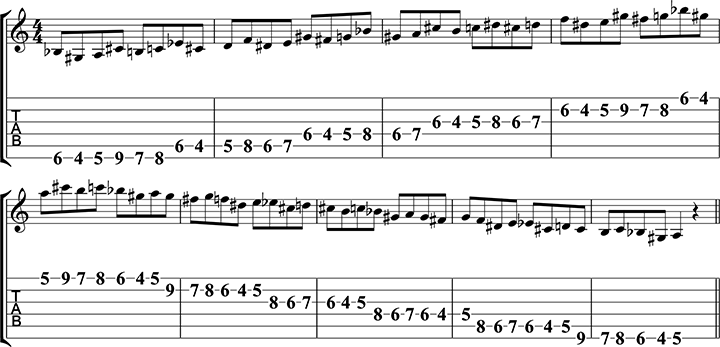
The final idea used in this jazz guitar improvisation post is half-step enclosures, a melodic idea used frequently by the great jazz guitarist Joe Pass. Enclosures are notes that surround a scale note. If you play one fret above a scale note, then one fret below, and finally playing the scale note, you have a half-step enclosure. The above exercise places enclosures on each step of the scale.
I find that half-step enclosures are quite a ‘spicy’ solo ingredient, so in a real solo you would only use these occasionally. However, just as with the previous steps, experiment on the backing track exclusively using enclosures without other ideas initially. Doing so will train your ear to their sound so you have more intuition when to include them in your soloing.
Step 7: Combine all the above ideas together (13:16)
So you have all your ingredients now, now it’s time to combine them into a tasty solo! Deliberately try to incorporate all the above ideas as you practice with the backing track. Pick perhaps just 2 of the ideas at a time, and then finally combine them all as you improvise.
The magic starts to happen once you have really internalised the vocabulary, and aren’t so much consciously thinking about using a piece of vocabulary in a solo. Just like when you get fluent in a spoken language, you don’t need to think of every single word that you say, you are just spontaneously communicating with someone. This feeling in your solos will come with time as you become more acquainted with the jazz vocabulary.
Handy Resources for Download
To help you to follow along the process that I’ve covered in this lesson, I’ve put together a downloadable pdf that summarises all the scale shapes and variations used in this post, so that you can quickly get started with this approach to jazz guitar improvisation that I’ve outlined in the article above:
In Closing…
I hope that this beginner’s guide on jazz guitar improvisation has helped you learn this crucial musical skill that is overlooked by many guitarists. Improvisation is a wonderful way to express yourself in your music and is a great way to develop aural skills too. I am excited to share more jazz guitar lessons in the future on this blog.
Thanks very much for reading and I hope you had some good takeaways out of this lesson. I would really appreciate your feedback, so do let me know what you think about this post by leaving a comment below. If you enjoyed this post and would like to be notified when my next posts are coming out, make sure to subscribe to the blog by entering your details below if you haven’t already. I wish you the best in your improvisation journey!
Special thanks to Matt Warnock who originally shared the pentatonic scale ideas with me that were featured in this post.
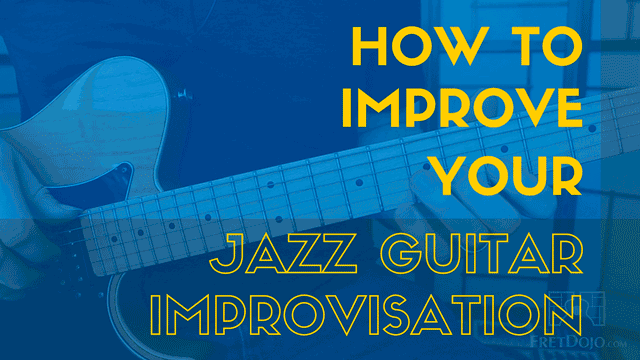
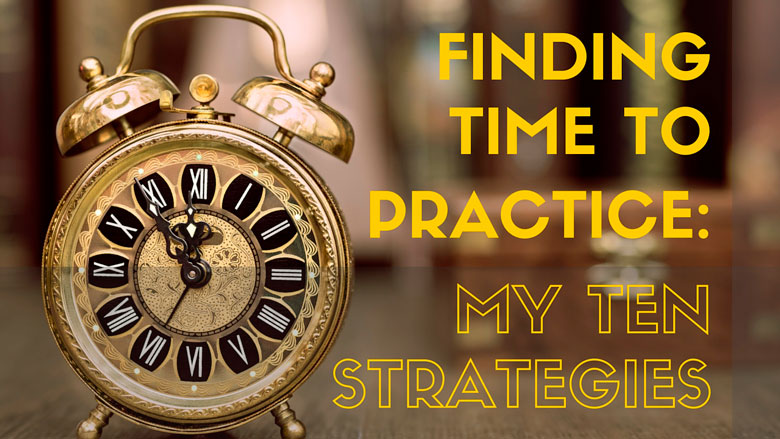
This is exactly what I needed as I am in the area of learning this scale. My teacher taught it to me yesterday, now I have things to practice with as I move forward. Thank-you for the easy to understand method of putting your lessons together.
That’s great Chuck – When I was shown this approach I was really drawn to it as it is a very natural way of learning jazz vocabulary. It’s also a very good way to memorise scale shapes like this.
this is about the best Beginner Jazz lesson i’ve found, Without much complicating terms & theories,. For me, This kind of a teacher is A Genuine Teacher who’d just like to share & impart things without making himself look impressive, deep & intimidating, Real focus is to share & Sincerely want to make People understand & learn things,. So Thankyou, keep them coming please, i’m Also A Music / Guitar teacher, from the Philippines
Hi Christopher, thanks so much for your kind feedback! If there’s one thing I’ve learnt about jazz, it’s this: Jazz doesn’t need to be hard to sound good! I wish you well on your soloing journey :-)
that is a easy to do the pentatonics
nice piece, very straightforward, good content, multiple levels and applications. Thank You
My pleasure Donald, thanks for reading :)
Thanks for this, Greg. This is most helpful. Ir’s simple to understand and is practical, and it didn’t load me with fancy jazz terminology. Many other teachers impress with convoluted theory and terms I don’t understand to get their point across, but this is great.
Thanks Jeremy! The concepts and terminology can be useful if taught well, but yes students can get too bogged down and confused if they overload on all that – jazz at it’s core is very elegant and simple I think. The best approach is to pick one tune and work a few ideas into that tune, so at the end of the process you have a finished piece of music you can play on your own or in a jam session. Yesterday I was listening to Matt Warnock being interviewed on Justin Sandercoe’s new podcast that summarises the process really well – check it out at http://www.justinguitar.com/en/PO-005-Podcast-E5-InterviewMattWarnockJazz.php
Cool stuff Greg,
Very interesting ideas for both the beginner and the more experienced guitarist, a valuable addition to the toolbox of anyone who plays either within the boundaries of jazz or those beyond!
Best regards,
Tim.
Grazie
la lezione è fantastica anche perchè non costringe a martellarsi il cervello per imparare a memoria stili e\o posizioni ma stimola la fantasia e la creativita’ che deve esistere in ogni chitarrista
So many ありがとう’s
A great lesson! As good a way to get started as I’ve heard. Your blood’s worth bottling, as they say in your neck of the bush.
Thanks Douglas, much appreciated! Hehe I’m sure you won’t believe me but even though I’m an Aussie I’ve never in my life heard that phrase :) I had to look it up in the Urban Dictionary! I’m very humbled :)
Hi, nice recommendations for the beginning. I read many such instruction in e-books and printed one but I miss some good ideas to change for the 4th or 5th used in many songs. Mostly the pentatonic, scales and arpeggios goeas up and down. When a simple songe changes e.g. for Am to Dm and the to E7 and back I would like to get some hints. I try myself to stay in one fret porsition and change only the one or other tone, but I am sure there are other and better ideas. Nice greetings from Vienna!
Thanks George! In future posts we’ll get into more complex scales and ways to play over changes – stay tuned!
Thanks from Ohio, USA, for the lesson Greg. The simplicity of the approach belies the complexity of the material. Well taught.
Thanks Larry! I’ve found that many of my students have gotten a lot out of approaching improvisation in this way, it’s a great way to get started in the style.
I like your approach and the way you communicate it. So much of what’s online is really only marginally useful, but I found this lesson well thought out, and the emphasis on limiting practice sessions to just an idea or two is right on. This is a scale I’ve know for a very long time, but have used only for blues. Employing it in a jazz context is extremely useful. Thanks for a really fine lesson.
No probs Dave! Glad you found this lesson useful :)
Really enjoyed the lesson, it’s a great introduction to Improvising, made me look at the whole concept from a different perspective, thank you very much.
Thanks Ron! Look forward to seeing you at our Skype lesson tomorrow :)
Thank you very match for this lesson!! This really help me to start improvising. Best wishes from Lithuania
My pleasure Gintautas, great to help this have given you a good start with jazz improv. Cheers!
THANX GREG,
I NEED TO PRACTICE MORE
Thank you so much for this strait forward approach I bin taking lesson for years and you taught me more in a 10 minute lesson than I learned in 6 months. Thank you.
Greg,
what amplifier do ypu use?
I use a Boss Katana 100 amp – sounds great with both solid body and archtop. Also has a quite good acoustic amp setting for acoustic guitars with pickup – very versatile amp with a great sound.
Thank you for breaking the mystery of Jazz down for me, from my perception of Jazz being something “unattainable” for me, or at the very least, years of tough study to even be a beginner at Jazz… To something that I already know (the first position pentatonic scale) and some very crafty uses of it, to in turn make it sound “Jazzy”… Thank you from the bottom of my heart.
I don’t play a lot of Jazz being a country player (mostly major pentatonic scale) and have often wondered “HOW” to make some of my country playing sound Jazzy as I LOVE the sound of jazz infused with country (and how Willie Nelson uses those Jazzy Blues licks he does in his country playing) it just adds so much spice and flavour and really impresses everyone.
For me to now know how to do this I’m very grateful and will invest in some of your courses to learn more.
Hello Greg
I stumbled across this lesson that I really like to work on and I would like to know if in the other positions on the neck of the pentatonic A we are obliged to keep the same fingerings?
This makes practice more difficult!
cordially
Bernard
You can use any positions of the neck Bernard, but this particular position indicated in this lesson is particularly good for this exercise. Hope this helps!
Hi Greg, I watched one of your youtube videos last wk-end and had to request your free material. As a result, I got the narrative of what your program had to offer. I Immediately purchased the Beginners Jazz Course. Well, I jumped the gun. Within a day I received the Dojo Blues and the Jazz Guitar Chord Primer. I also received the Beginners Jazz Course. I noted there was a 30 day challenge with the Beginner program. So-o-o-h, I better get to marching. I opened Module 1 and completed lessons 1 and 2. No sweat. I liked the listening, I needed it. Then I opened lesson 3. Panic!! I was like a turkey in a hail storm. Two days latter problems solved. I received the Improvisation e-book along with the other two e-books. I have read the three books. Right now I’m putting together a Jazz Chord Dictionary file with chords in your Chord Melody Basics e-book. I may not meet the 30 day challenge in the Beginner Jazz program. If I can get through the material in the free e-mail books in 30 days I will be very happy. The Speed Building Lesson is really welcome. Thank you Greg!
Wow!! “It’s a new world; it’s a new day” Thank you for this holistic lesson!
Thank you Greg for this great lesson. Very easy explaned. For me is it a huge step forwards for my soloing skills. Do you have more lessons that are so well and easy understandible like this?
Great, well done!!